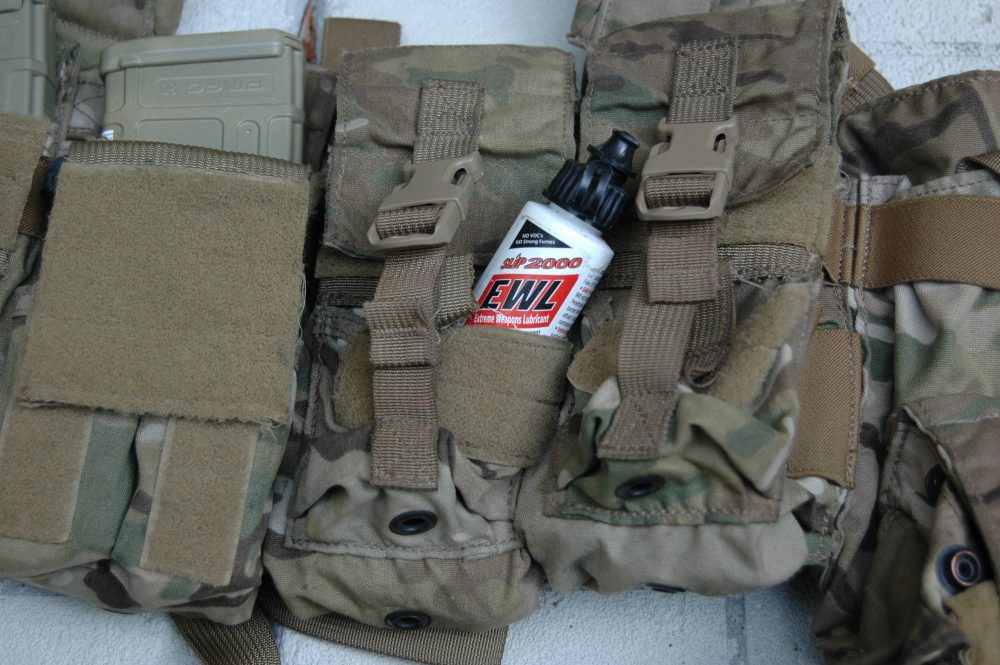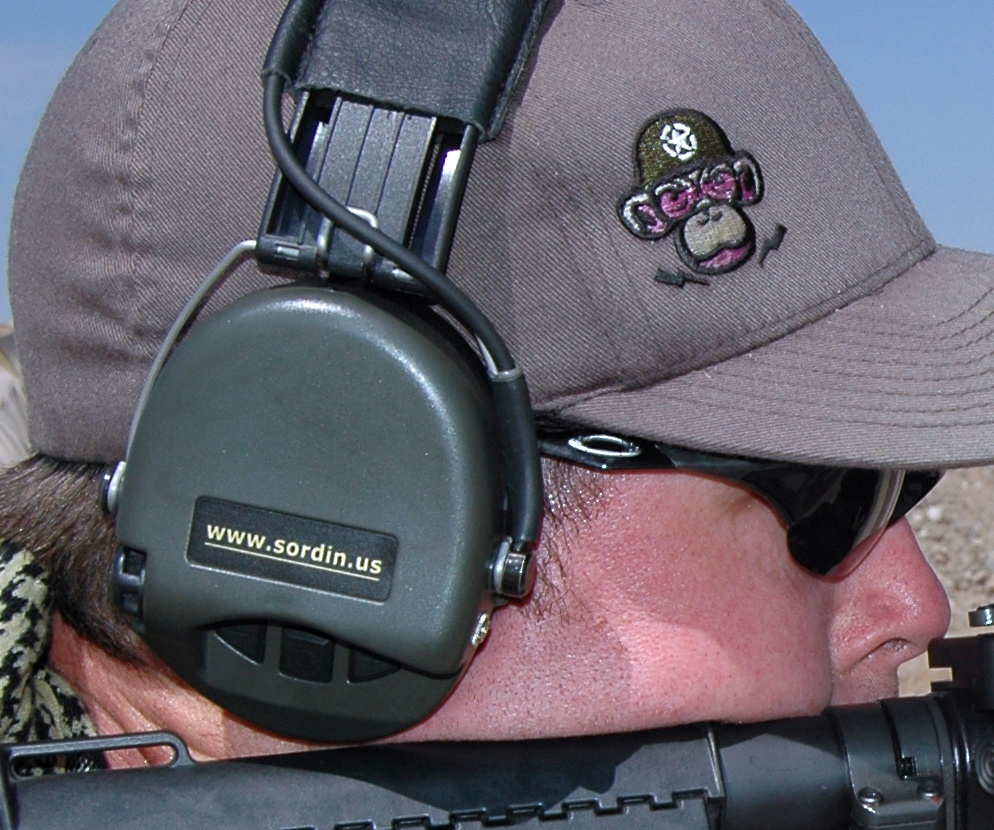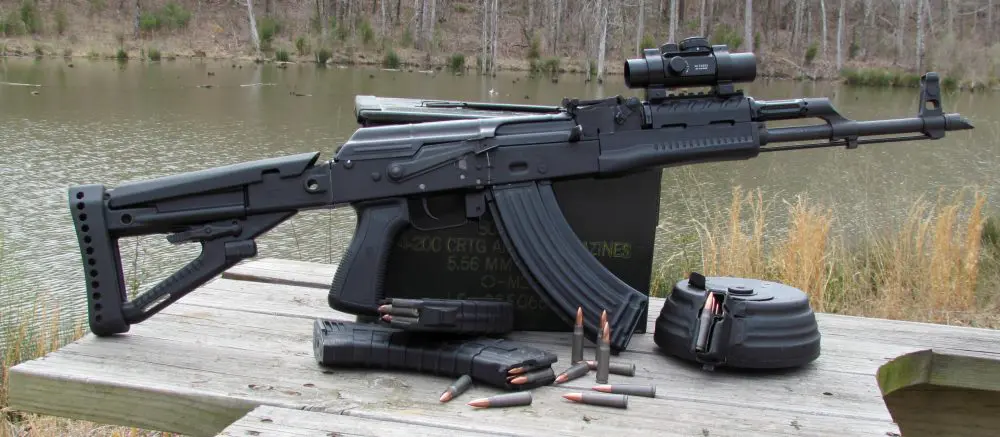As time marches inexorably on, we see more and more of the same problems cropping up in class. Or as the great Yogi Berra once said, “It’s déjà vu all over again.” The reasons may be many, but generally fall under the category of “You don’t know what you don’t know.”
The equipment aspects have been covered, and continue to be covered, in great depth, probably because buying something is way easier than doing something.
Mindset issues have always been difficult, because only a few are blessed with that mean gene that permits them to fight other bipeds to the death without remorse. Not many can embrace the hate efficiently.
Your lube must be immediately available. Author keeps one-ounce bottle of Slip 2000 Enhanced Weapon Lube in a pocket on his vest. It won’t do you any good if it’s in your kit bag.
And finally, the integration of biomechanics, equipment and the desire/ability to get all of these things working at the same time to more efficiently service the threats in front of you is not a simple matter.
What follows is directly applicable to training, and training is directly applicable to fighting.
First off we need to understand that a carbine is (by one of the many definitions) a weapon with a shorter stock and barrel than the rifle, but firing the same cartridge as the rifle. Thus the U.S. Carbine, Caliber 5.56mm M4/M4A1 is shorter than the U.S. Rifle, Caliber 5.56mm, M16A2/A3/A4. Clearly the U.S. Carbine, Caliber .30 M1 (M1A1, M2 and M3) was an exception to this.
The carbine is used more as a close-combat weapon and is most effective in that envelope that extends from near-contact distance out to 200 meters. While the M4A1 and MK18 are certainly capable of achieving solid hits out to and past 200 meters, terminal ballistics is compromised. Understand that while the M16A2-A4 is capable of hitting point targets at 600m, not only are terminal ballistics in the toilet, but target acquisition is seriously degraded.
The infantry fight is—and has been for many years—in the under-200 meter arena.
Consequently, the way we fight with the carbine is significantly different than the way Uncle Fester hunts deer with .270 Model 70 in Colorado. And, it is light years different than the way that the yellow glass crowd fires across the course at the National Matches. Remember that marksmanship—the ability to decisively hit the target—is but one part of the equation.
Make prominent paint marks so you can match the accessory to the carbine (in this case, a rack number) as well as witness marks on the mount and the rail.
Table of Contents
HOLD ONTO THE CARBINE
This sounds silly, but probably the most common mistake we see is that the shooter does not maintain a firm grip on the gun. Your hands—both of them—are maintaining a firm firing grip on the gun, and pulling it straight back into your shoulder. You need to do this in any position you are firing from.
A very common error is to relax when in kneeling or prone, or shooting at distance. If you relax, you will have inconsistent shot groups, and someone will be sure to inquire as to the type of choke you have on the barrel of your carbine.
Consistency is the key to accuracy. Do it the same way every time and you won’t have to ad hoc in different positions.
KEEP THE CARBINE IN YOUR SHOULDER
This goes hand in glove (metaphorically speaking) with the above. In days of old, when rifles were made of steel and stocks of wood, we raised our elbow high and made a shoulder pocket for whatever gun we were shooting. The configuration of the AR has the stock in line with the bore—a major plus in controlling the gun. The sights are therefore higher (approximately 2.6 inches, depending on the sight).
But the much-loved shoulder pocket cannot be formed as we are fighting with the gun, and the “classic rifleman” stance of sideways to the target with left elbow high went the way of fifty cents-per-gallon gasoline.
We also fight with armor now, and while some vests (like the OTV or MTV) were apparently not designed to properly interface with the carbine, others were.
All is not, however, lost. We wind up wearing other pieces of gear that may require over-the-shoulder straps (CamelBaks come to mind). Place the toe of the stock inboard of that strap. It will keep the stock from slipping off your vest—a very good thing.
I had a shooter in a recent class who was having horrible hits while standing. It wasn’t until we got to the shooting on the move stage that we cured him of his poor trigger control, absence of follow-through and other issues. Here we found that he was deliberately holding the carbine about two inches off of his shoulder. The sad part is that he was doing this intentionally because he read that the (insert offshore SOF here) did it that way. Sigh…
The stock has to be firmly in contact with some portion of your upper body.
Powered ear pro protects ears from damage, but also enhances hearing. Microphones are directional and are normally turned forward for operational use. Brady Miller, who has a very cool job, has his Sordin’s turned to the rear to better hear instructions.
IF IT IS ATTACHED TO THE GUN, MARK IT
On your spouse’s next trip down to JoAnn’s Fabric, instead of whining and stamping your feet, go into the dang store and pick up some Sharpie’s Paint pens. I prefer Aqua, but I’ll leave the color choice up to you. Just make sure you can easily see it. (No, you do not have to turn in your Man Card if you are entering the store on gun-related business.)
Make a prominent mark on the attached item as well as on the carbine. Make another mark across any screws—this will give a handy visual indicator if those pesky devils start to unwind under the punishing recoil (mandatory sarcasm included).
Those in the military should be doing this, but some armorers—frequently the bane of my existence—want optics removed so that the carbines will fit in the rack. Often the optics are not issued to a single shooter, and he may just get the next in line. If the sight is marked with the carbine’s rack number, and witness marks are on the sight and the receiver, hey, you may actually have a rifle with a solid zero.
What joy!
IF IT IS ATTACHED TO THE GUN, USE LOCTITE®
A thread locker is not a luxury, it is a necessity. Vibration will cause threaded devices to loosen. Every time you press the trigger, vibration will cause those nuts and screws to loosen. Once they loosen, you will suffer a loss of zero for sighting devices, and eventually the object will part company from the gun. We see this once or more at every class. Use Loctite®. Note that it doesn’t last forever, and you may have to reapply it at intervals.
Simple chest rigs can make life a lot easier. They can hold from three to eight magazines or more. Having the ability to immediately manage and access ammunition makes life much easier. Don’t overload your chest rig, but make sure that you have sufficient ammunition to cover all eventualities. Here two shooters at recent EAG class at Eloy, Arizona PD range perform speed reload drills. Shooter in foreground has dumped his empty mag—his trigger finger is straight and he has acquired a spare magazine from his emergency reload pouch.
IF IT IS ATTACHED TO THE GUN,
TIGHTEN IT EVERY CHANCE YOU GET
That means at least once daily, and more if you are shooting. Everyone should have a CGT (Cool Guy Tool) on their gear. The manufacturer isn’t important, but having something that will fit all of the slot, hex, Phillips and torx fasteners on your carbine is considered a good thing. When you get some down time, break the CGT out and give the screws a nudge. You may be surprised at the results.
HAVE LUBE AVAILABLE
As in immediately available.
We know that more lube is better than less, but you need to have it on your person. Too often a shooter will flat forget something silly like putting oil on the gun in the morning and, in the middle of a 134-round exercise in mid-afternoon, discover that there are functioning problems. I carry a one-ounce bottle of Slip Enhanced Weapons Lube in my load carriage and wind up replacing it often, as I pass it out among those who neglected to bring any.
A gallon of lube in your car is worth nothing. Two drops on your person may be the difference between you shining or becoming “That Guy”.
AMMUNITION MANAGEMENT: BRING MORE AMMO THAN YOU NEED
If you think that three magazines will do it, bring five—or six. You may wind up with a bad mag. Or someone else might have a bad mag and you’ll need to spread the load to keep people in the fight. Too much ammo only presents an issue in carrying it.
Ashleigh Clark conducts strong-hand-only Box Drill. She is holding carbine tight against her shoulder, her strong side arm is against her body to add support, and she is able to complete the drill (hammer, hammer, brain, brain) accurately and rapidly without a problem.
AMMUNITION MANAGEMENT: BACKFILL YOUR MAG POUCHES
You should have previously identified an emergency reload pouch that will be your “Go To” pouch for an emergency (or speed) reload. However, you may find yourself in a position where you may have done one or more of these reloads. During your down time, instead of contemplating your navel, take magazines from the least accessible pouches and backfill the more accessible pouches.
AMMUNITION MANAGEMENT:
HAVE SOME LOOSE CARBINE AMMO IN YOUR VEST
The military calls a place that stores ammunition an Ammunition Supply Point, or ASP. If you have a small MOLLE pouch or pocket, designate it as your ASP and keep some loose rounds therein. It will pay off in the end for malfunction drills and the like.
MAINTAIN SITUATIONAL AWARENESS
This shouldn’t be an issue, but it always is. Pay attention. Pay attention to what you are doing and to what is going on around you. Listen to commands from the instructors.
A cool tip here is to have electronic ear protection—it will pay for itself in one class. Having said that, turn the headset around so that the microphones are facing the rear. You need to hear what commands are being passed. You have absolutely no need to hear the bullets striking the paper bad guys.
DRINK AND EAT
Don’t use plain water—mix it with an electrolyte replacement. Bring a CamelBak to the line. If you wind up on the line for more than five minutes, you will need liquid. It does you no good back at your vehicle. Having a CamelBak ensures that you will have fluid on board.
Training is not the proper time to go on a diet. Eat food. Food is energy. Without food and water, you will become weak, unaware and unresponsive. As soon as it is apparent to an instructor, you will be sitting out the drills instead of shooting them.
SUMMARY
There are many ways to screw things up so badly that you may never recover. There are, however, a whole lot of issues that can be resolved when you develop a combat mindset, seek good initial and sustainment training, and understand that the fight won’t always be in the middle of a sunny and cool afternoon, just after you have finished a three-week CQB course.
Use common sense, and research your needs. The errornet can provide some useful information, but most of what is passed on the bubble gun forums comes from the poster playing video games in his mother’s basement.
Be prepared to change all that you had believed in on Training Day 1 when you find out that things don’t work as you believed they would. And be prepared to reconfigure both your equipment and your mind to deal with whatever is in front of you.
Keep your head in the fight.
[Pat Rogers is a retired Chief Warrant Officer of Marines and a retired NYPD Sergeant. Pat is the owner of E.A.G. Inc., which provides services to various governmental organizations. He can be reached at [email protected]]











